This trip was not to be a usual coyote hunt in that I also had a female scimiter horned oryx on the agenda. I have hunted nilgai on the ranch for over ten years, and been around the oryx, but never hunted them before. All of the exotics on this 11,000 acre ranch are free roaming and stalking the herd animals can be a challenge sometimes due, not only to game density, but the fact that the cattle are wild range cattle and as apt to spook as not when they see a human.
To add to the challenge, I was nursing a bum left knee making the uneven terrain even more of a hassle. Have heard that oryx are a pretty tough animal to put down so loaded up the .338 Win. Mag w/my favorite nilgai load using a 210 gr. Nosler partition that shoots flat and hits hard.
My hunting partner and I arrived Tuesday evening in time to make a couple of dry stands and do a little scouting to locate several herds of oryx. Our plan was to call early and late and then see if we could slip up on cow in between stands. This was made a bit more difficult in that I went off without my standing shooting sticks and had to carry my shooting chair and short sticks since my knee wouldn’t allow me to get in kneeling or sitting position on the ground.
A heavy fog rolled in Wednesday morning, limiting visibility to about 50 yards with a very light SE breeze. Made one dry stand in the SE corner of the ranch, a spot that had proven to be a good one in years past. Not so this morning, however.
We moved a couple of miles and set up back to back on an outer ranch fence and started calling. About 15 minutes into the stand, I spot a coyote charging toward the call on the opposite side of the fence. He tried unsuccessfully three or four times to cross through the hog wire fence, running right past decoy & call before finally finding a spot to his liking. I’m not sure if he got hung up in the fence or just paused to look up and down the two track, but the "right" end was on my side of the fence and he met his maker, his back end still on the next ranch. He kicked a couple of times and actually fell the rest of the way through the fence.
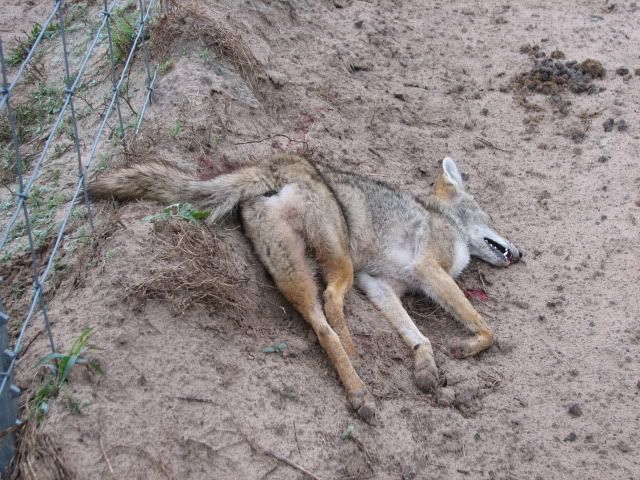
We moved a mile or so and set up with our backs to a cattle guard on a wide pipeline sendero bordered on both sides by short mesquite brush and thick broomweed. Several thick mesquite motts dot the area on both sides of the pipeline. The fog has thinned out a bit w/visibility between 75 and 100 yards. Started out w/lucky bird and about 12-15 minutes in, this large old male trotted out of the broomweed and stopped 75 yards out when I barked.
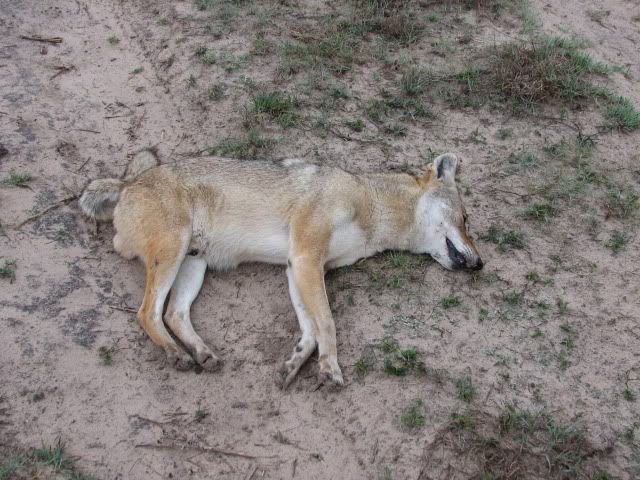
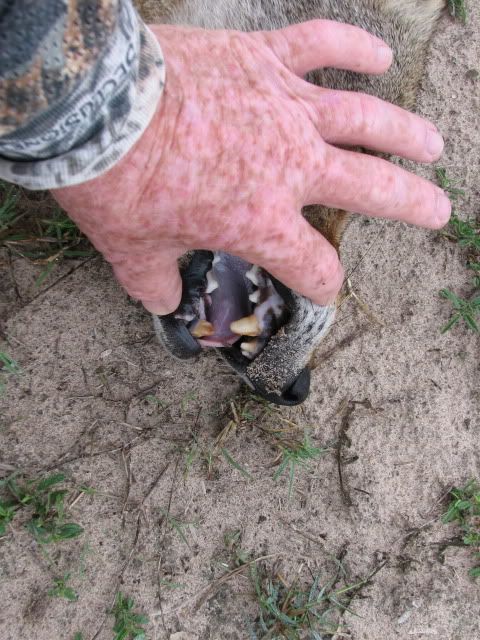
While we were picking up the coyote and our gear, we noticed a large herd of oryx about a mile down the pipeline and decided to switch gears.
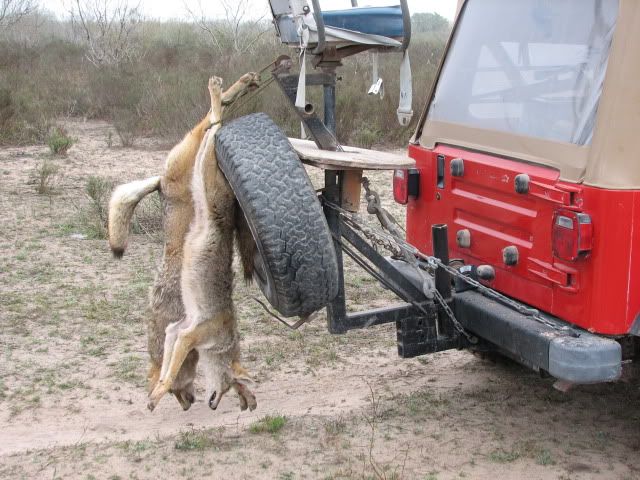
They appeared to be in a dry lake bed that crossed the pipeline. Since this is another favorite coyote stand location, we knew the area quite well so drove to a point from which we thought we could approach unseen. We parked the jeep and slipped up to the pipeline just as the last of the herd moved off into the mesquite mott to the right of the pipeline.
I eased toward where they disappeared, planning to set up beside a large catclaw bush, hoping some might wander back into view. As I stepped past a fairly thin mesquite bush, I spotted a large area of white through the trees and froze. Part of the herd had gathered in the edge of the laguna no more than 40 or 50 yards from me. Since they had not spotted me, I quickly sat in the chair and set up the sticks to wait them out.
Using binoculars, I could make out a head here, a hip there and some legs over there. Pretty soon, several of the animals bedded down, others seemed to be moving around feeding. A herd of range cattle complicated the situation when they moved between the oryx and I and stopped, staring at me. The cattle on this ranch are wild and often spook at the sight of a human so I didn’t move at all and they finally wandered off; all the while giving me the evil eye. Fortunately, the oryx didn’t pick up on the cattle’s concern so I dodged another bullet.
For those who have never hunted oryx, both the cows and bulls have horns. The cows can have longer horns than the bulls but the bulls often have a bit heavier horns. The only sure way to determine gender is to check out the plumbing, which, on a bull is located about the middle of their pot belly, and let me tell you, there is not much there to look at….about one inch and that’s it! Any high grass or other vegetation further complicates the situation.
After what seemed like an hour, but was probably only twenty or thirty minutes, a lone oryx stepped back into view about 175 yards down the pipeline and proceeded to graze. I was unable to determine sex of the animal as there was some high bushes obscuring the view. Fifteen minutes later, a second animal emerged 150 yards away.
I’m 99% sure this one is a cow, but a negative is always harder to prove than a positive, so I waited, hoping a bull would step out for comparison. Another 10-15 minutes pass and three more animals join the group and yes, one is a bull.
My cow, was now surrounded by the three new arrivals, so had to wait for a clear shot. She finally cleared the other animals and gave me a good broadside shot. She nearly fell at the shot, but managed to retain her footing and sprinted into the nearby brush. The rest of the herd stampeded at the shot and I forced myself to wait 15 minutes before checking out the results. As I walked toward where she stood, I looked out into the brush and saw a group of animals about 50 yards out. Decided to give it another ten minutes as I figured if she was still on her feet and the herd bolted, she would try to follow and could make recovery a lot more difficult. Ten long minutes later, as it turned out, she had fallen where this group of animals had stood and I was able to get the jeep in close enough to hook the winch on her and drag her out.
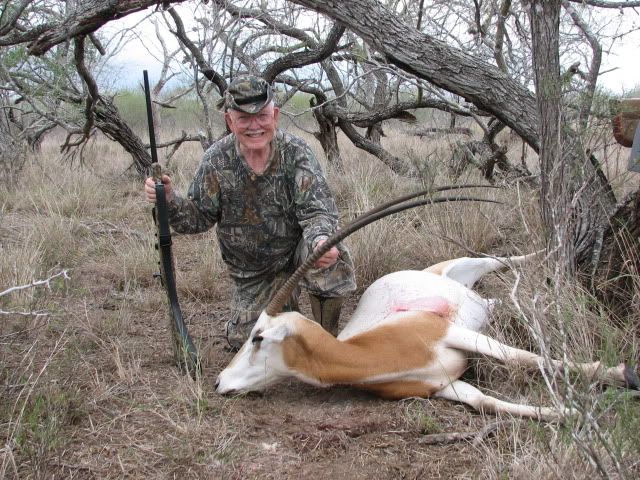
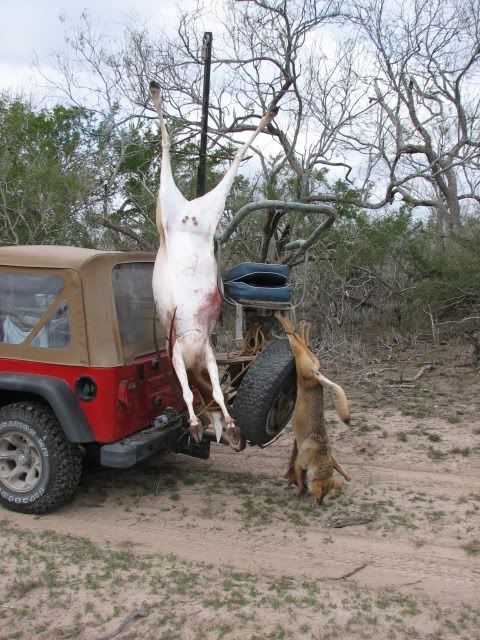
All in all, not a bad morning. Ya gotta love hunting in S. Texas!
Regards,
hm
To add to the challenge, I was nursing a bum left knee making the uneven terrain even more of a hassle. Have heard that oryx are a pretty tough animal to put down so loaded up the .338 Win. Mag w/my favorite nilgai load using a 210 gr. Nosler partition that shoots flat and hits hard.
My hunting partner and I arrived Tuesday evening in time to make a couple of dry stands and do a little scouting to locate several herds of oryx. Our plan was to call early and late and then see if we could slip up on cow in between stands. This was made a bit more difficult in that I went off without my standing shooting sticks and had to carry my shooting chair and short sticks since my knee wouldn’t allow me to get in kneeling or sitting position on the ground.
A heavy fog rolled in Wednesday morning, limiting visibility to about 50 yards with a very light SE breeze. Made one dry stand in the SE corner of the ranch, a spot that had proven to be a good one in years past. Not so this morning, however.
We moved a couple of miles and set up back to back on an outer ranch fence and started calling. About 15 minutes into the stand, I spot a coyote charging toward the call on the opposite side of the fence. He tried unsuccessfully three or four times to cross through the hog wire fence, running right past decoy & call before finally finding a spot to his liking. I’m not sure if he got hung up in the fence or just paused to look up and down the two track, but the "right" end was on my side of the fence and he met his maker, his back end still on the next ranch. He kicked a couple of times and actually fell the rest of the way through the fence.

We moved a mile or so and set up with our backs to a cattle guard on a wide pipeline sendero bordered on both sides by short mesquite brush and thick broomweed. Several thick mesquite motts dot the area on both sides of the pipeline. The fog has thinned out a bit w/visibility between 75 and 100 yards. Started out w/lucky bird and about 12-15 minutes in, this large old male trotted out of the broomweed and stopped 75 yards out when I barked.


While we were picking up the coyote and our gear, we noticed a large herd of oryx about a mile down the pipeline and decided to switch gears.

They appeared to be in a dry lake bed that crossed the pipeline. Since this is another favorite coyote stand location, we knew the area quite well so drove to a point from which we thought we could approach unseen. We parked the jeep and slipped up to the pipeline just as the last of the herd moved off into the mesquite mott to the right of the pipeline.
I eased toward where they disappeared, planning to set up beside a large catclaw bush, hoping some might wander back into view. As I stepped past a fairly thin mesquite bush, I spotted a large area of white through the trees and froze. Part of the herd had gathered in the edge of the laguna no more than 40 or 50 yards from me. Since they had not spotted me, I quickly sat in the chair and set up the sticks to wait them out.
Using binoculars, I could make out a head here, a hip there and some legs over there. Pretty soon, several of the animals bedded down, others seemed to be moving around feeding. A herd of range cattle complicated the situation when they moved between the oryx and I and stopped, staring at me. The cattle on this ranch are wild and often spook at the sight of a human so I didn’t move at all and they finally wandered off; all the while giving me the evil eye. Fortunately, the oryx didn’t pick up on the cattle’s concern so I dodged another bullet.
For those who have never hunted oryx, both the cows and bulls have horns. The cows can have longer horns than the bulls but the bulls often have a bit heavier horns. The only sure way to determine gender is to check out the plumbing, which, on a bull is located about the middle of their pot belly, and let me tell you, there is not much there to look at….about one inch and that’s it! Any high grass or other vegetation further complicates the situation.
After what seemed like an hour, but was probably only twenty or thirty minutes, a lone oryx stepped back into view about 175 yards down the pipeline and proceeded to graze. I was unable to determine sex of the animal as there was some high bushes obscuring the view. Fifteen minutes later, a second animal emerged 150 yards away.
I’m 99% sure this one is a cow, but a negative is always harder to prove than a positive, so I waited, hoping a bull would step out for comparison. Another 10-15 minutes pass and three more animals join the group and yes, one is a bull.
My cow, was now surrounded by the three new arrivals, so had to wait for a clear shot. She finally cleared the other animals and gave me a good broadside shot. She nearly fell at the shot, but managed to retain her footing and sprinted into the nearby brush. The rest of the herd stampeded at the shot and I forced myself to wait 15 minutes before checking out the results. As I walked toward where she stood, I looked out into the brush and saw a group of animals about 50 yards out. Decided to give it another ten minutes as I figured if she was still on her feet and the herd bolted, she would try to follow and could make recovery a lot more difficult. Ten long minutes later, as it turned out, she had fallen where this group of animals had stood and I was able to get the jeep in close enough to hook the winch on her and drag her out.


All in all, not a bad morning. Ya gotta love hunting in S. Texas!
Regards,
hm


